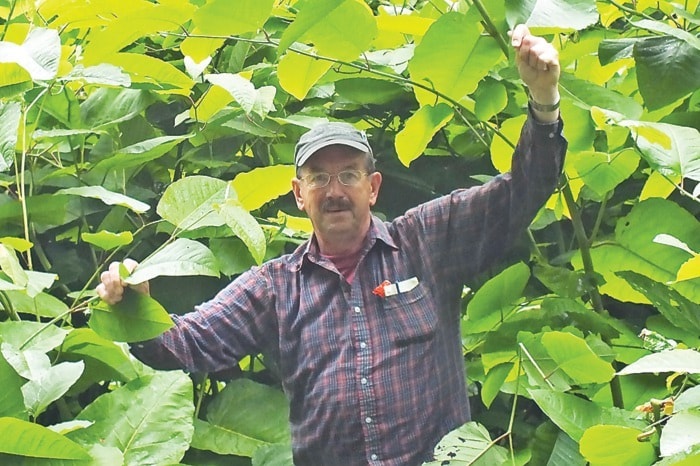Rhubarb fans are putting away the last of this summer’s crop, and whatever didn’t go into muffins, crisps, jams, or syrup, is safely frozen for a mid-winter treat.
A member of the buckwheat clan, rhubarb is related to wild dock and sorrel plants. It’s not a fruit, but a vegetable, with stalks resembling celery. The leaves contain oxalic acid and can ruin an otherwise healthy compost heap.
Not everything rhubarb is sweet and good.
A similar introduced (imported) species, giant knotweed (Polygonum sachalinense), grows on Vancouver Island and along the West Coast where it has become naturalized. Many wild food enthusiasts appreciate the young, tender and edible shoots that cook up just like rhubarb.
Long considered medicinal, Both giant knotweed and Japanese knotweed are commercial sources of the powerful antioxidant Resveratrol. Despite its healing benefits, no one admires this perennial weed’s aggressive and noxious behaviour.
Giant knotweed is a bane to the environment because of its invasive nature. Introduced from Asia as a garden ornamental, this huge plant often exceeds three metres in height. The botanical name, polygonum, translates as “many joints or knees,” as the plant’s hollow stems feature distinct raised bamboo-like nodes (joints) at regular intervals.
There’s no mistaking the giant, heart-shaped leaves, ranging in size from 15-30 cm, and at least 2/3 as wide. Heart-shaped leaves, however, aren’t enough to make us love this import.
Dense thickets exclude other vegetation, while deep, creeping rhizomes make eradication difficult; new shoots can even grow through asphalt. It can resprout from fragments and create new infestations along streams whenever plant parts fall into the water. This difficult freshwater weed degrades native plant and animal habitat by choking it out.
Campbell River’s Greenways Land Trust continues to battle this escaped ornamental, and Nunns Creek Park knotweed plots are studied to determine best practices for eradication.
Giant knotweed infests wetlands and waterfronts (Campbell River estuary, Willow Point waterfront), the Cumberland Wetlands, and waterways in the Comox Valley.
Despite its remarkable size, bamboo-like poles and plate-sized leaves, it is ‘knot’ bamboo, and we don’t want it in our wild lands.
Contact Christine by e-mail: wildernesswest@shaw.ca.
